The "La Peregrina" PearlIntroduction:
Her jewelry collection -including a necklace with the Peregrina pearl- was auctioned off by Christie's, on December 13, 2011. The necklace with the Peregrina pearl was sold for just under $12 million ($11,842,500). |
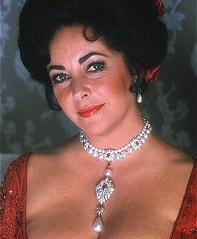 |
The pearl is of particular interest to the friends of the John & Mable Ringling Museum of Art. This article has researched and concluded that the pearl on the hat of Philips IV (a painting by Velazquez in Gallery 14) is the actual "La Peregrina" pearl. The same argument goes for the pearl in a painting of Doña Mariana, hanging in Cà d'Zan, giving these paintings' history and content an additional dimension.
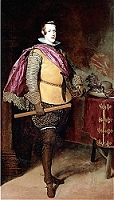 Philip IV |
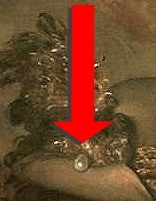 La Peregrina pearl |
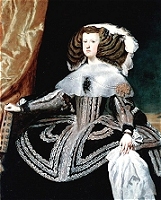 Doña Mariana |
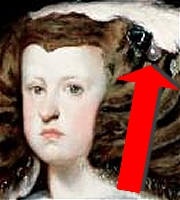 La Peregrina pearl |
This article will take you on a journey, tell the history and show paintings and photographs of the owners of the pearl. At the end the provenance of the pearl is discussed further and which factors and calculations determined if a pearl in the paintings shown was actually the Peregrina.
Origin of name
La Peregrina is a Spanish word. It means "the Pilgrim" or "the Wanderer".
Physical characteristics
The "La Peregrina" pearl is one of the most famous pearls in the world with a recorded history of nearly 500 years. It is a large pear-shaped white nacreous pearl whose original weight was 224 grains (56 carats). At the time of its discovery, it was the largest pearl ever found.
The length is 1 inch (exact size is: 17.90 mm wide x 25.50 mm long)
History
The pearl was found by an African slave on the coast of the isle of Santa Margarita in the Gulf of Panama in the mid-16th century. The pearl was given to the administrator of the Spanish colony in Panama. The slave who found it was rewarded with hisfreedom.
The pearl was carried to Spain and given to King Charles V (reign: 1516-1556), who made it part of the Spanish Crown Jewels.
His son Philip II (reign: 1556-1598) was married 4 times and he gave the pearl to all his wives:
- 1543: Philip II married his double-cousin Maria Manuela of Portugal (1527–1545). Maria died soon after she gave birth to Infante Carlos of Spain (1545–1568).
- 1554: married Mary Tudor of England, daughter of Henry VIII, just two days after their first meeting. She is 11 years older.
In the marriage with Philip she became queen consort of Habsburg Spain on his accession in 1556.
Philip presented his bride with the pearl. Several portraits were painted of Queen Mary wearing it. Also, a coin was struck with their portraits and Mary wearing the pearl.
View here.
Mary is remembered for her restoration of Roman Catholicism. During her five year reign, she had over 280 religious dissenters burned at the stake in the Marian Persecutions. Her Protestant opponents gave her the sobriquet of "Bloody Mary". Her re-establishment of Roman Catholicism was reversed after her death in 1558 by her successor and younger half-sister, Elizabeth I.
After her death in 1558, the pearl was returned to the Crown of Spain, where it remained, as part of the crown jewelry, for the next 250 years. It became one of the favorite ornaments for the Spanish queens during those years.
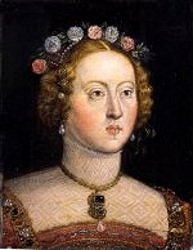 Maria Manuela |
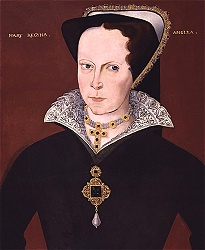 Mary Tudor. 1554. Artist unknown. |
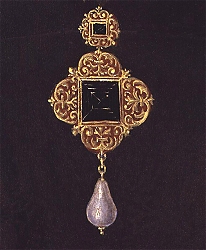 Close-up of pearl. |
- 1560: Philip married Élisabeth of Valois. She was born in the Château de Fontainebleau. Her childhood was spent in the French royal nursery, where she shared her bedroom with her future sister-in-law, Mary, Queen of Scots, who was about the same age.
Philip was completely enchanted by his 14 year old bride. Élisabeth gave birth to Infanta Isabella Clara Eugenia in 1566, and then to Isabella's younger sister Catherine Michelle one year later. Look here for a portrait of the two young sisters and Catherine wearing the pearl.
Élisabeth had a miscarriage in 1568, and died the same day, along with her newborn infant son.
- Philip was now looking for his fourth wife, since he had no male heir since Don Carlos died. In 1570: Philip married his niece Ana of Austria (1549-1580).
She was the eldest daughter of Holy Roman Emperor Maximilian II and Maria of Spain. It was Philip's fourth marriage, but the king still had no male heir. Anna completed her duties flawlessly in that regard. Not only was she a good step-mother to Philip's daughters Isabella Clara Eugenia and Catherine Michelle, but she also gave birth to five children. Three boys, who died young, and then in 1578 she gave birth to Philip III, who would succeed his father.
Ana died of heart failure in great pain after giving birth to her last child. A girl, who would live only 3 years.
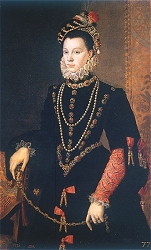 Élisabeth by Anguissola 1565. |
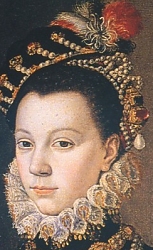 Detail. |
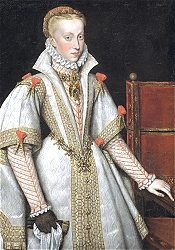 Ana by Bartolomé González |
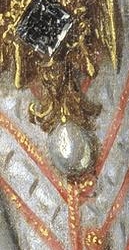 Detail |
Philip III (1578 – 1621):
Philip II died in 1598 and was succeeded by his son Philip III. An introspective and deeply religious man. He left government to corrupt ministers and devoted himself to the interests of the church. During his reign, agriculture and industry declined, and foreign wars drained the treasury.
In 1599 Philip III married his cousin, Margaret of Austria, a year after becoming king. Margaret was the sister of the future Emperor Ferdinand II. Margaret was considered by contemporaries to be extremely pious and very skillful in her political dealings.
Philip had an 'affectionate, close relationship' with Margaret and paid her additional attention after she bore him a son in 1605. This was Philip IV.
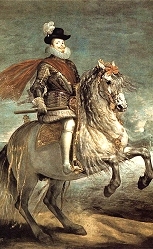 Philip III by Velazquez |
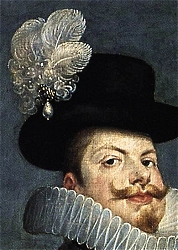 Detail. |
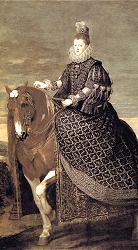 Margaret by Velazquez |
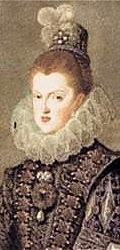 Detail |
Philip III wore the pearl on his hat in several portraits. Margaret also wore the pearl in several portraits and for the celebration of the peace treaty between Spain and England in 1605.
In 1611 Margaret died while giving birth to her youngest child, Alfonso. Philip never remarried and died ten years later.
Philip IV (1605 – 1665): King of Spain for 44 years. From 1621 to his death in 1665.
In 1621 Philip IV becomes King of Spain. He was 16 years old.
Before then, in 1615, at age 10, he was married to Elisabeth of France. Philip had seven children with her, but only one son, Baltasar Carlos who died young at the age of sixteen. They also had a surviving daughter Maria Theresa, who became the wife of Louis IVX of France in 1660.
 Philip IV. Ringling M. |
 Detail |
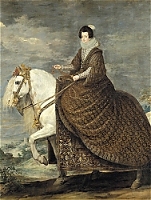 Elisabeth of France 1635. |
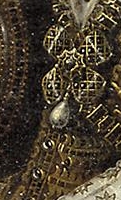 Detail |
Philip remarried in 1646, following the deaths of both Elisabeth and his only legitimate heir. His choice of his second wife, Maria Anna, known as Mariana of Austria, Philip's niece and the daughter of the Emperor Ferdinand, was guided by politics and Philip's desire to strengthen the relationship with Habsburg Austria.
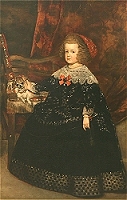 Daughter Maria Theresa. |
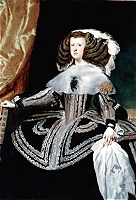 2nd wife Mariana. Ringling Museum. Click |
 Mariana detail Ringling Museum |
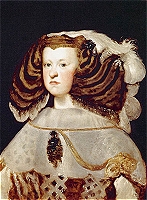 Mariana by Velázquez |
Look at that face of Marianna. Isn't that the unhappiest face you have ever seen?
Here is another painting of her unhappy face and wearing the pearl.
The poor girl is only 14 years old and she must marry an old uncle in a strange country with a strange language for the only reason to produce heirs. Marry a husband who had numerous mistresses. It was said that Philip had sired thirty-two (32) natural children of whom he acknowledged eight (8). Now you understand her face.
Although known for being cheerful as a young girl, after her wedding to her uncle Marianna became cold and bad-tempered. I wonder why.
Mariana had six pregnancies, but only 2 children lived into adulthood. A daughter, Margaret Theresa, who was to marry her maternal uncle Leopold I, Holy Roman Emperor and a son, the future Charles II of Spain, who was born physically and mentally disabled, and disfigured.
The portraits by Diego Velázquez and Juan Bautista Martinez del Mazo show that the pearl was prized by both wives of Philip IV of Spain and daughter Maria Theresa.
Philip himself was the talk of the town, when he wore the pearl on his hat at the wedding of his daughter Maria Theresa to "The Sun King" Louis XIV in Paris in 1660.
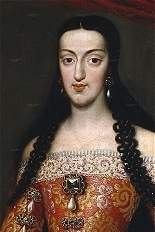 Maria Louise. Maria Louise. |
Charles II (1661 – 1700): In 1679, the 18-year-old Charles II married Marie Louise d'Orléans (1662–1689), eldest daughter of Philippe I, Duke of Orléans (the only sibling of Louis XIV) At that time, Marie Louise was known as a lovely young woman. It is likely that Charles was impotent, and no children were born. Marie Louise became deeply depressed and died at 26, ten years after their marriage, leaving 28-year-old Charles heartbroken. |
| Still in desperate need of a male heir, the next year he married the 23-year-old princess Maria Anna of Neuburg, a daughter of Philip William, Elector of the Palatinate. However, this marriage was no more successful than the first in producing the much-desired heir. Both wives of Charles II wore the pearl in various portraits |
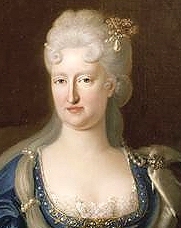 |
Philip V (1683 – 1746):
When Charles II died in 1700, the line of the Spanish Habsburgs died with him.
Almost immediately the War of the Spanish Succession (1702–1713) began. After eleven years of bloody, global warfare, fought on four continents and three oceans, the Duc d'Anjou, as Philip V, was confirmed as King of Spain. He was the great grand-son of Philip IV (through his daughter Maria Theresa and Louis IVX). Philip was the first member of the House of Bourbon to rule as king of Spain. The sum of his two reigns was 45 years.
The House of Bourbon still rules Spain today (2011).
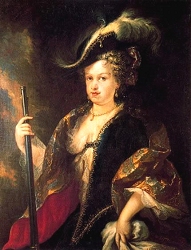 Maria Luisa. |
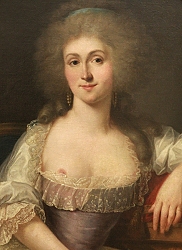 Rather risqué |
In 1701 Philip married the 13-year old Maria Luisa of Savoy. They had four sons. She is wearing the pearl in the portrait on the left. Rather risqué. No pearl in her portrait on the right, but I added it, because I thought it was interesting that Queen Maria Luisa had herself painted that way. |
Shortly after her death the King decided to marry again. His second wife was Elizabeth of Parma (1692 – 1766). At the age of 21, she married in 1714. They had seven children.
Elizabeth survived her husband by twenty years. The 2nd painting is Barbara of Portugal (d. 1758). Wife of King Ferdinant VI. She wears the pearl. |
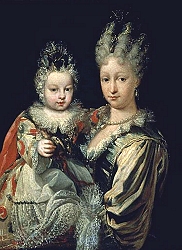 Elizabeth of Parma Elizabeth of Parma |
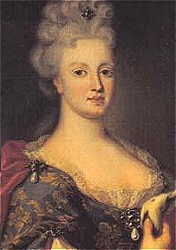 Barbara of Portugal |
There are a few more generations of Bourbons at the Spanish court, who will have worn the pearl. Paintings of them are now in a looser style, making it difficult to accurately measure the size of the pearl and are therefore not included in this article.
At the beginning of the 19th Century the pearl was brought to France.
Continue on page 2 and read how the pearl went from Spain to the Bonaparte family in France, to England and then to the USA.